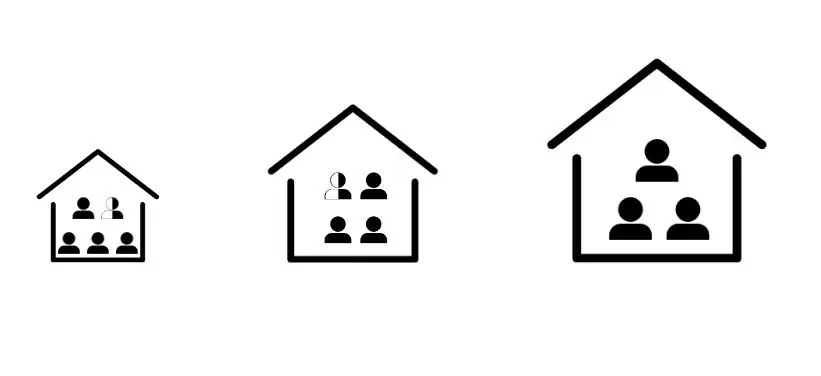First Home Buyer Guidance
Step by step help with grants, finance and floor plans, move into your first home sooner.

Coliving is transforming modern housing by tackling the challenges of affordability, convenience, and community living.
This style of living provides an all inclusive arrangement, often covering essentials like utilities, Wi Fi, and cleaning, while also encouraging meaningful social interaction.
These elements meet the needs of today’s renters, blending affordability and convenience with a genuine sense of community.
Shared spaces in coliving homes transform accommodation into more than just housing. They become lively hubs where residents connect and collaborate. Well designed areas act as the heart of the community, making daily interactions natural and helping people feel at home.
Community Engagement
Strong coliving design supports many social needs. For example, a large kitchen with an island naturally gathers residents for meals and conversation. Comfortable lounge areas with mixed seating allow both quiet chats and group gatherings.
Co working spaces have become essential with the rise of remote work. Good lighting, ergonomic furniture, and options like phone booths or private rooms make them practical for focused tasks.
Entertainment areas such as games rooms also encourage interaction. Whether it’s a pool table, board games, or a shared TV area, these features spark casual socialising that often turns into real friendships. When these spaces flow easily into each other, residents naturally feel drawn to join in.
Flexibility and Accessibility
Community areas need to work for people with different lifestyles. Round the clock access is vital, making spaces just as useful for an early coffee as they are for late night study sessions.
Flexibility matters. Moveable furniture and dividers allow the same room to host yoga in the morning and birthday celebrations in the evening. Shared storage for games or sports gear keeps spaces tidy while promoting communal use. These details make coliving more functional while supporting its values of affordability and ease.
Balance of Privacy and Shared Living
Great shared spaces create interaction but also respect personal space. Quiet reading corners let people enjoy the common areas without always having to socialise.
Sound management is important. Using materials that absorb noise and separating louder activities helps ensure comfort. For instance, lively conversations should not clash with kitchen sounds or entertainment noise.
The transition from private rooms to open spaces also plays a role. Hallways with seating or small alcoves offer natural spots for brief interactions without forcing residents into bigger groups.
When designed carefully, shared areas become the backbone of a positive coliving lifestyle. They create connections while still giving people personal space. Paired with flexible lease options, these thoughtful spaces make coliving an appealing choice for today’s renters.
Traditional apartment rentals often lock residents into year long contracts, which can feel restrictive in today’s fast moving, mobile lifestyle. Coliving offers a modern alternative with lease terms designed to match current work habits and flexible living needs.
Flexibility and Accessibility
Coliving stands apart with month to month lease options, giving residents freedom to extend or shorten their stay as needed. This model is especially attractive to digital nomads and remote workers who often move between different cities or countries.
For those needing shorter arrangements, such as interns, professionals on contract roles, or individuals testing a new city, stays from one week to three months are commonly available. These flexible terms reduce the stress of binding agreements and avoid heavy exit fees.
Many coliving spaces also provide easy to use booking systems, making it simple to extend stays when space allows. Transparent all inclusive pricing simplifies budgeting and minimizes unexpected costs, creating a smooth and predictable living experience.
Community Engagement
Flexible leases not only benefit individuals but also strengthen community life. Without the weight of long commitments, residents feel more relaxed and engaged. This creates a vibrant environment where new faces and fresh ideas continually add value to the shared community.
At the same time, adaptable agreements respect personal boundaries, offering a balance between shared social spaces and individual privacy.
Balancing Privacy and Shared Living
Trial stays are another advantage, giving residents a chance to test different rooms or community settings before making longer commitments. Seasonal flexibility also adds value, letting people adapt their environment to shifting needs. For example, a student may enjoy a lively atmosphere during term time but seek a quieter setting during summer work.
Coliving operators often provide cancellation options to reduce financial pressure during unexpected events like job relocation or family emergencies. These policies turn housing into a supportive system that adapts to both personal and professional changes.
When combined with practical amenities, flexible leases create a coliving solution that aligns seamlessly with today’s fast changing lifestyles.
In a world where connectivity drives daily life, utility are not just extras but the foundation of the coliving model. From video calls to creative sessions in shared spaces, fast internet and simplified utilities make everyday living smoother and more enjoyable.
Dependable Technology for a Connected Lifestyle
High speed internet is essential in coliving communities, particularly for remote workers and digital nomads. Reliable connectivity can often be a challenge for those moving around, but coliving solves this with dedicated coworking zones equipped with strong bandwidth to support many users at once.
Well run coliving spaces treat fast Wi Fi as a standard inclusion, knowing how crucial it is for both work and leisure. Beyond internet alone, strong tech infrastructure ensures residents have the tools to stay productive and connected at all times.
Simplified Living with All Inclusive Utilities
Bundled utility packages are a major advantage. By covering electricity, water, gas, internet, and often extras like waste removal or cable TV in one set payment, coliving eliminates the hassle of managing different bills and providers.
This model makes budgeting easier and prevents surprise costs, while also removing the stress of arranging new service connections. With everything handled by the operator, residents can focus on living rather than logistics.
Building Community Through Shared Resources
Shared utilities and connectivity go beyond cost savings — they also foster collaboration and community. By pooling resources, coliving can provide added amenities like cleaning, gyms, laundry, or coworking areas at a lower individual expense.
These shared benefits bring people together, encouraging interaction while keeping living costs predictable. In the end, high speed internet and bundled utilities create not only convenience but also a connected, community focused way of living.
Coliving is built on shared experiences and community, yet everyone needs a private retreat to recharge. The most successful coliving spaces recognize this, providing residents with personal rooms where they can rest, work, and relax. This focus on privacy complements the social benefits that make coliving attractive in the first place.
Finding the Right Balance
Balancing shared areas with personal rooms is essential. Private rooms should feel like more than a place to sleep — they should act as a personal sanctuary. Features such as built in workstations, quiet sleeping areas, sufficient storage, and ideally private bathrooms, greatly enhance the experience. Proper soundproofing is especially valuable, ensuring restful nights and peaceful calls without disruption. Even shared amenities can be designed with privacy in mind.
Smart Design for Comfort
Good design plays a major role in making private spaces both inviting and useful. Adaptable layouts, modular furniture, and clever storage solutions allow rooms to shift easily from a workspace in the day to a cozy retreat at night. Accessibility elements such as wide doorways, grab rails, and thoughtful details ensure these rooms are inclusive and functional for all residents.
Up To Date Tech
In today’s world, dependable technology is essential. Private rooms should feature individual climate control, conveniently placed power outlets, and USB charging points. Many coliving spaces also guarantee strong internet coverage for video calls, remote work, or streaming. This tech ready setup ensures that personal rooms meet the needs of modern living while supporting comfort and productivity.
Sustainability is no longer optional for modern renters. It has shifted from being a bonus to becoming a central factor that shapes the appeal of coliving communities. Younger generations, particularly Millennials and Gen Z, are drawn to housing choices that reflect their values, offering eco friendly living without giving up comfort.
Environmental Responsibility
Forward thinking coliving operators are embedding green practices into their daily operations, benefiting residents while reducing environmental impact. Energy efficient appliances, LED lighting, and programmable climate systems are commonly used to lower utility costs and cut emissions. Many communities also invest in solar panels to take advantage of renewable energy.
Water saving measures are equally important. Features such as dual flush toilets, low flow fixtures, and greywater systems significantly reduce usage. Some communities add smart water meters, giving residents visibility into their consumption and helping quickly detect leaks.
Reducing waste is also a major priority. Recycling, composting programs, and bulk purchasing are now standard. Some properties even partner with farms to turn food scraps into compost, creating a closed loop approach. These steps not only protect the environment but also promote shared responsibility among residents.
Community Engagement
Sustainability grows stronger when residents take part. Community gardens are a great example as they produce fresh food and double as social spaces where people learn, connect, and share skills. Over time, they become vibrant gathering points that deepen the sense of belonging.
Shared resources like tool libraries or communal appliances lower costs and waste while encouraging collaboration. Educational workshops on zero waste living, energy use, or sustainable habits further empower residents to make environmentally conscious choices every day.
Technological Sustainability
Smart technology is making sustainable living more practical and effective. Automated lighting adjusts based on occupancy or daylight, cutting down energy use without effort. Similarly, smart thermostats learn daily habits and optimize heating or cooling to save power.
Real time energy monitors are another step forward. These systems show electricity, water, and gas use in detail, sometimes even through digital dashboards that encourage friendly competitions to conserve. This turns sustainability into an engaging, community wide practice.
Transport is also being reshaped with technology. Many coliving communities now provide EV charging stations, bike share access, or carpool coordination apps. Some even supply electric bikes or scooters, making sustainable travel simple and accessible for residents.

August 9, 2023

August 9, 2023

September 20, 2023

March 10, 2024

September 20, 2023

January 28, 2025
Our Services
TPG Property Group supports Melbourne and Australia wide clients with land selection, finance, turnkey builds and long term strategy.
Step by step help with grants, finance and floor plans, move into your first home sooner.
Strategies for high growth suburbs, tax benefits and SMSF options that build wealth.
Low deposit options and competitive loans, with expert lender support and faster approvals.
Fixed price turnkey homes in Melbourne and Australia, fully finished and ready to move in.
Secure land in Melbourne growth areas, matched to your budget and lifestyle goals.
Stay in the suburb you love and upgrade to a modern, efficient new home.
Quality multi dwelling projects for lifestyle appeal and strong rental returns.
We manage design, permits, construction and handover, on time and on budget.
Trusted partners streamline contracts, settlements and loan approvals.
Data led suburb insights and feasibility reviews for smarter decisions.
Plan, acquire and manage a long term portfolio that grows with you.
All contents published on this website or otherwise made available by TPG Property Group Pty Ltd to you is general information only and is intended to help you in understanding the products and services offered by TPG Property Group Pty Ltd. The information does not take into considerations of any particular investment objectives or financial situation of any potential reader. It does not constitute, and should not be relied on as, financial, investment, legal or any other professional advice or recommendations both expressed or implied. It should not be used as an invitation to take up any investments or investment services. You are advised to do your own due diligence when it comes to making financial and investment decisions and should use caution and seek the advice of qualified professionals such as accountant, lawyer, or other professional advisors before acting on this or any information. TPG Property Group Pty Ltd, its employees or contractors do not represent or guarantee that the information is accurate or free from errors or omissions and therefore provide no warranties or guarantees. You may not consider any examples, documents, or other content on the website or otherwise provided by us to be the equivalent of professional advice. Nothing contained on the website or in materials available for download on the website provides professional advice in any way. TPG Property Group Pty Ltd disclaims any and all duty of care and liability and assumes no responsibility for and you will indemnify TPG Property Group Pty Ltd against any losses or damages resulting from your use of any link, information, or opportunity contained within the website or any information within it.